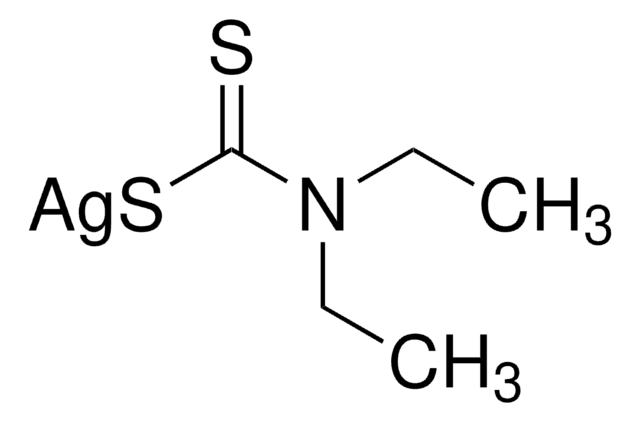1.01515
Silver diethyldithiocarbamate
for analysis EMSURE®,Reag. Ph Eur
Sinonimo/i:
Silver diethyldithiocarbamate, Diethyldithiocarbamic acid silver salt
About This Item
Prodotti consigliati
agenzia
reag. Ph. Eur.
Livello qualitativo
Nome Commerciale
EMSURE®
Saggio
≥99 % ((DSC (differential scanning calorimetry)))
Stato
solid
pH
5.0-6.5 ( in H2O, suspension)
Punto di fusione
178-183 °C
Densità bulk
340 kg/m3
Temperatura di conservazione
2-8°C
Stringa SMILE
CCN(CC)C(=S)[S-].[Ag+]
InChI
1S/C5H11NS2.Ag/c1-3-6(4-2)5(7)8;/h3-4H2,1-2H3,(H,7,8);/q;+1/p-1
NSVHDIYWJVLAGH-UHFFFAOYSA-M
Categorie correlate
Applicazioni
- Arsenite tolerance and removal potential of the indigenous halophilic bacterium, Halomonas elongata SEK2.: This study explores the application of silver diethyldithiocarbamate in bioremediation, specifically its role in enhancing arsenite removal by Halomonas elongata SEK2. This research provides insights into the potential of using complexed silver compounds in environmental cleanup efforts, particularly in saline environments where traditional methods may fail. The findings could significantly impact wastewater treatment and environmental sustainability practices (Tavoosi et al., 2024).
- The development and use of an innovative laboratory method for measuring arsenic in drinking water from western Bangladesh.: This paper details the use of silver diethyldithiocarbamate in a novel analytical method to measure trace levels of arsenic in drinking water. This development not only enhances the accuracy and sensitivity of arsenic detection but also demonstrates the critical role of silver diethyldithiocarbamate in public health monitoring, offering a significant improvement over traditional testing methods (Frisbie et al., 2005).
- Methods of analysis for toxic elements in food products. 2. Review of USSR standards on determinations of heavy metals and arsenic.: This review discusses various methods, including the use of silver diethyldithiocarbamate, for the analysis of toxic elements in food products. The article highlights the importance of stringent quality control in food safety and the role of advanced chemical reagents in ensuring the reliability of detection methods in the food industry (Skurikhin, 1989).
Risultati analitici
Identity (IR-spectrum): passes test
Appearance of solution (in pyridine): passes test
pH-value (aqueous suspension): 5.0 - 6.5
Melting range (DSC (differential scanning calorimetry)): 178 - 183 °C
Spec. Absorptivity A 1%/1cm (of the As-complex; 525 nm; 0.00033 %; 1 cm; pyridine): ≥ 1500
Nitrate (NO₃): ≤ 0.01 %
Loss on Drying (105 °C): ≤ 0.5 %
Sensitivity (for determination of arsenic): passes test
Note legali
Non trovi il prodotto giusto?
Prova il nostro Motore di ricerca dei prodotti.
Codice della classe di stoccaggio
11 - Combustible Solids
Classe di pericolosità dell'acqua (WGK)
WGK 3
Punto d’infiammabilità (°F)
Not applicable
Punto d’infiammabilità (°C)
Not applicable
Certificati d'analisi (COA)
Cerca il Certificati d'analisi (COA) digitando il numero di lotto/batch corrispondente. I numeri di lotto o di batch sono stampati sull'etichetta dei prodotti dopo la parola ‘Lotto’ o ‘Batch’.
Possiedi già questo prodotto?
I documenti relativi ai prodotti acquistati recentemente sono disponibili nell’Archivio dei documenti.
I clienti hanno visto anche
Il team dei nostri ricercatori vanta grande esperienza in tutte le aree della ricerca quali Life Science, scienza dei materiali, sintesi chimica, cromatografia, discipline analitiche, ecc..
Contatta l'Assistenza Tecnica.






